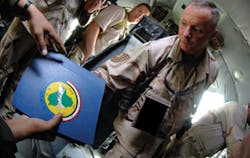Sather Air Base, Iraq — On a daily basis, Staff Sgt. Luke Almeter dons his US Air Force uniform and drives the short commute to New Al Muthana Air Base. This seemingly easy task is something his Iraqi Air Force counterparts can’t do because of the dangers lurking outside the base.
Because of fear of retribution, Iraqi airmen don’t tell their relatives or neighbors they’re members of the IAF. They don’t go home often and they live inside the base’s secure compound. They’re literally deployed in their own backyard.
Even with the constant elements of danger they face, the Iraqi airmen continue to perform their nation’s bidding. With the help of the US Air Force, the IAF is answering their country’s patriotic call of duty.
Along with a whole slew of Airmen, Almeter’s role as an aircraft fuels systems adviser is contributing heavily to the IAF’s ability to become a self-sustaining air force.
These Airmen — serving six-month and one-year deployments — serve with the Coalition Air Force Transition Team (CAFTT) and are assigned to the new 370th Air Expeditionary Advisory Squadron.
The CAFTT’s primary responsibility is to effectively help facilitate the IAF’s reconstitution. The 370th AEAS mission is to restart the IAF, modeling some US systems that will effectively allow the Iraqis to solely maintain, fly and operate C-130 aircraft.
Inside the office room of a massive hangar, Tech. Sgt. Kerry Belcher sat behind her computer rapidly typing away. She was busy taking part in a project that will mirror the Air Force’s supply system.
The new automatic system for supply processes has proven to be invaluable. “We now have an 86 rating on our mission capabilities,” Belcher says. “That’s up from a 40 rating just a few months ago and that’s directly attributed to the new supply system.”
As a combat aviation material management advisor, she helps the Iraqis develop a self-sustaining supply system. “Our overall goal is to help them keep their planes flying in support of their cargo and troop movement, distinguished visitor and occasional humanitarian missions,” Belcher says.
The C-130 aircraft is widely known as one of aviation’s most effective workhorses therefore, the maintenance performed on it must be flawless.
That task falls on the shoulders of Capt. Marty Sisson’s 32-member maintenance staff. “I coordinate my staff’s needs, guide the Iraqi’s maintenance leadership and advise them on proper practices and procedures,” Sisson explains. Sisson has also introduced the first self-aid buddy care course and a technical English class to assist with the maintenance jargon.
Out on the flight line, Tech. Sgt. Judd Wasylow, a reservist from the 934th Maintenance Squadron at the Minnesota Air Reserve Station, is impressed with the Iraqi maintainers’ work performance.
“They can do a lot of stuff on their own,” the 10-year C-130 crew chief says. “We diligently work with them and check their efforts and they normally do a job well-done.”
That diligence brings a smile to Wasylow’s face. “As the mentor of the most advanced mechanics, I’m very happy to work with them because they like what they do and I really like these guys,” he says. A western greeting with one of the Iraqi maintainers was a clear sign of just how much Wasylow enjoys their company.
Through their time spent together, the Iraqi airmen have learned to observe some American holidays and events, too.
“Thanksgiving was a big deal for them,” says Master Sgt. John Gahan, an evaluator loadmaster. “They went out of their way to make us feel at home and that was a very special feeling.”
Forging friendships through mutual trust shows the advancement taking place. “With a good-working professional and personal rapport, we’re helping to put the stamp on a fledging air force,” says Senior Master Sgt. Sean Wong, evaluator loadmaster.





